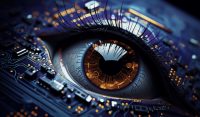CES: Image Sensors Adapt to Light Changes Like Human Eye
January 16, 2025
CES’s Eureka Park is a section of exhibits where startups and early-stage products from all over the world solicit feedback and explore opportunities. From this year’s Italian delegates at Eureka Park, our team found EYE2DRIVE, a semiconductor company that develops CMOS chips for digital imaging inspired by the human eye. Their image sensors use AI to mimic the human eye’s ability to adapt its response to changing environmental light conditions. As a result, quality and color of the captured image remains unaffected. While currently focusing on autonomous navigation applications, the tech has potential for media production as well.
EYE2DRIVE co-founder and CEO Monica Vatteroni told us that current image sensors could not handle flickering imagery because the brightness level is varying too rapidly. Or, consider the scenario when one goes into or out of a dark tunnel. The brightness is changed so extremely that the camera is essentially “blinded” as it produces overexposed or underexposed imagery until the aperture or shutter speed is adjusted either manually or automatically.
However, the human visual system has no problem adjusting to the transition.

Vatteroni explained that their image sensor solves this problem by using machine learning to monitor changes in lighting for every pixel. Then the sensor parameters are modified accordingly so the exposure level of the captured image remain constant. Since this control algorithm occurs at the chip level, the response is immediate.
One can think of situations in film production when lighting cannot be controlled. For example, in documentary filmmaking the crew could be moving the camera across environments with different lighting. Driving scenes can be traversing through areas with shadows or patchy lighting. EYE2DRIVE’s innovation could help mitigate uneven camera responses.
Since EYE2DRIVE’s technology has to be designed into an image sensor chip, this requires close collaboration with a device manufacturer to incorporate their IP. The company has found that makers of automobile Lidar devices could be more open to a partnership and decided to focus on this industry for their initial focus. (They changed their name to EYE2DRIVE from EYE-TECH.)
Deploying their IPs into cameras may be saved for later phases.

No Comments Yet
You can be the first to comment!
Leave a comment
You must be logged in to post a comment.